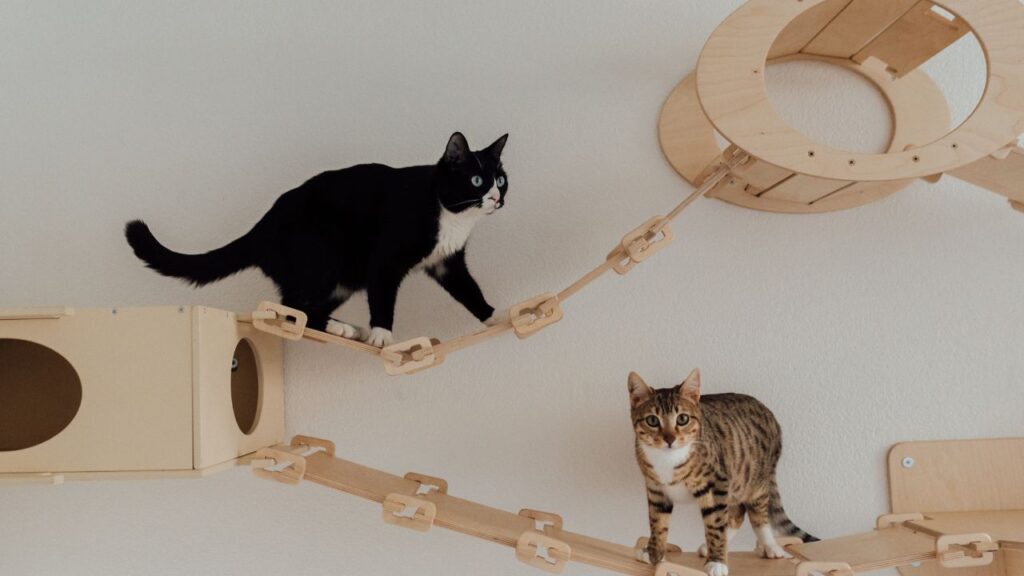We’ve all been there: You’re trying to comfort your cat, but instead of curling up in your lap for a snuggle, they’re huddled in the corner, eyes wide with terror, tail puffed up like a little broomstick. It’s heartbreaking, isn’t it? You just want to scoop them up and tell them, “Hey, it’s okay!” But cats, being the independent and sometimes unpredictable creatures they are, don’t always take to comfort the way we might expect. So, how to handle a scared cat? What’s the secret to getting them to trust you when they’re hiding under the couch like a little fuzzball of fear?
Let’s dive into this (no pun intended, but we’ll take it) and figure out how to help your scaredy-cat feel more secure, one gentle step at a time.
Step 1: Recognize the Signs – What’s the Cat Trying to Tell You?
Before you rush in with the treats or a warm blanket, it’s crucial to understand why your cat is scared in the first place. Because let’s be honest—cats are as good at hiding their feelings as they are at ignoring you when you call their name.
So, what are the signs? You might see a cat cowering, ears flattened, wide eyes, a twitchy tail, or, in some extreme cases, a cat that hisses or swats at anything that comes near. Sounds dramatic, right? But it’s just their way of saying, “I’m freaked out. Please don’t make it worse.”
Real-world example: My friend Sophie recently adopted a cat from the shelter, and for the first week, poor Mr. Whiskers spent most of his time hiding behind the couch. She didn’t know if it was because of a past trauma or just the stress of a new home, but whatever it was, he was terrified. And Sophie’s first instinct? To pick him up and cuddle him like she’d seen in the movies. (You know, where the cat instantly melts in your arms.) But nope, that just made Mr. Whiskers more scared.
Take a step back. Let’s give them space.

Step 2: Give Them Space—Seriously, Give Them Space
It might sound counterintuitive, but distance can be your best friend when it comes to a frightened cat. If your cat is hiding under the couch or in a corner, your first move should be to let them come to you. A scared cat won’t want to be smothered or chased down, so try not to force interactions.
I know, I know. You just want to show them love and reassurance, but cats are naturally more comfortable in control of the situation. The best way to gain their trust is to make them feel like they have the freedom to choose. It’s like when you’re feeling off—sometimes, all you need is a little time to yourself before you’re ready to talk about it.
Pro tip: Set up a quiet, cozy space where your cat can retreat if they’re feeling overwhelmed. A little bed or blanket in a low-traffic area can give them a sense of security. Think of it like a cat-sized version of a “chill-out zone.”
Step 3: Speak Their Language – Slow, Calm, and Steady
It’s easy to get frustrated when your cat’s not responding to your attempts at comfort, but remember: you’re the one who needs to adjust, not them.
Cats are sensitive to tone. Ever noticed how they perk up when they hear your voice, even if you’re just talking to yourself? That’s their way of recognizing you. So, when you approach a scared cat, use a calm, quiet voice. Think of it like speaking to a toddler who just fell down and scraped their knee. You wouldn’t shout at them, right? Same deal with your cat.
Don’t rush or make sudden movements either. Slow and steady wins the trust race. A gentle, slow hand (not a fast swoop) will make them feel less threatened.
Step 4: Allow Them to Approach You (On Their Own Terms)
Here’s the deal: Never corner your cat. If they’re hiding in their favorite spot, resist the urge to invade their safe space. Instead, wait. If your cat wants to come out, they will. And if they don’t? Respect that. Maybe it takes a few hours or even days, but let them take the lead.
Anecdote time: I had a foster kitten once who was terrified of human touch. For the first few days, I just sat near her, reading or working on my laptop. I didn’t try to pet her. I didn’t try to play with her. I just let her exist in my space. Slowly, she started inching closer. One day, she nudged my hand, and that was the moment I knew—she was ready.
Patience pays off. Don’t force it.
Step 5: Use Positive Reinforcement – Yes, Even Cats Need Encouragement
Cats love rewards (who doesn’t?), and using positive reinforcement can go a long way in helping them feel more comfortable around you. Treats are an obvious choice, but even just a calm pet or a soft spoken “good kitty” can make them feel more secure.
Think about it like this: Would you trust someone who only scolded you when you did something wrong? No, right? Cats are the same. So when your cat takes a brave step—like coming out of hiding or sitting near you—reward it. Let them know they did something good.

Step 6: Avoid Overstimulation
Here’s the thing: Cats have limits. Just like people, they can get overwhelmed. If your cat is already nervous, avoid overwhelming them with too much attention, loud noises, or sudden movements. I know, it’s tempting to shower them with love, but sometimes, less is more.
Think of it like a big party. You wouldn’t throw someone who’s shy into the middle of the dance floor, right? Start slow. Let them warm up to your presence in their own time.
Step 7: Don’t Forget the Vet – Sometimes Fear Is More Than Just Fear
If your cat’s fear doesn’t seem to subside or if they’re showing signs of distress that aren’t just anxiety-related, it’s time for a vet visit. Sometimes, unexplained fear or behavioral changes can be linked to pain or illness.
Remember, it’s always better to be safe than sorry. If your cat’s scared of something that wasn’t there before, it could be a sign that something’s not quite right. Don’t ignore it.
In Conclusion: How to Handle a Scared Cat
Handling a scared cat isn’t about forcing them to “get over it” or training them like a dog (because, let’s be real, that’s not how cats roll). It’s about showing patience, respect, and understanding.
Every cat is different—what works for one might not work for another. But the core idea is the same: let them take their time, provide comfort, and respect their boundaries. When you approach it with kindness and empathy, you’ll find that your cat will eventually come around.
So, the next time your cat hides from you after a scary noise or a visit to the vet, just remember: they’re not rejecting you—they’re seeking safety. And in the end, isn’t that what we all want? A little peace, a little comfort, and maybe—just maybe—a little love.

